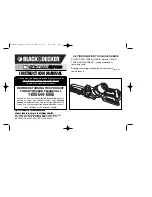
6. TROUBLESHOOTING
1. Get the machine checked by expert
personnel.
DANGER - WARNING
NEVER ATTEMPT TO REPAIR THE
MOTOR YOURSELF: IT COULD BE
DANGEROUS.
2. Check the fuses and replace them if
necessary.
3. Check the mains power system is
present.
4. Let go of the start button and wait for the
thermal circuit breaker to reset itself (a
couple of minutes).
1. Check that motor ventilation air uptakes
are not clogged or obstructed.
2. Perform cutting by applying the right
pressure on the workpiece.
3. Get the machine checked by expert
personnel.
1. Perform calibration by slackening the
fi xing screws and repositioning the
stoppers.
1. Reduce cutting pressure.
2. Check the cutting parameters in the
relative cutting chart.
3. Check adjustment of the blade guide.
4. Check the position of the workpiece and
that it is securely held in the clamp.
5. Check the blade tension
1. Check the cutting parameters (blade
tooth, cutting speed) in the relative cutting
chart.
2. Reduce cutting pressure.
1. Get the pulleys checked and if necessary
replaced, by expert personnel.
2. Never use lubricants or coolants of any
kind. Get the pulleys checked and if
necessary replaced, by expert personnel.
The motor
isn't working.
Tripping
of the thermal
circuit breaker.
Imprecise
cutting angle at
0° - 45°.
Imprecise
squaring of cut
The fi nish of the
cut is rough
or irregular.
The blade tends
to jump out of the
guides.
1. Faulty motor, power cable or
plug.
2. Blown fuses in the electrical
cabinet.
3. No voltage in the mains
system.
4. The motor’s thermal circuit
breaker has tripped.
1. The motor has overheated.
2. Motor overload caused by
excessive cutting pressure.
3. Motor fault.
1. The calibration of the stoppers
(26) is incorrect.
1. Excessive cutting pressure (on
tubes and profi les).
2. Incorrect blade toothing for the
material being cut.
3. Cutting speed not right for the
workpiece being cut.
4. Incorrect adjustment of the
eccentric and sliding blade
guides.
5. Incorrect positioning of the
workpiece in the clamp.
Poor blade tension
1. The blade is worn down or the
teeth are not suitable for the
thickness of the material being
cut
2. Excessive cutting pressure.
1. Excessive wear on the rubber
coating of the pulleys.
2. Slipping of the blade on the
pulleys.
PROBLEM /
PROBABLE CAUSE
REMEDY
FAULT
36
EN
















































